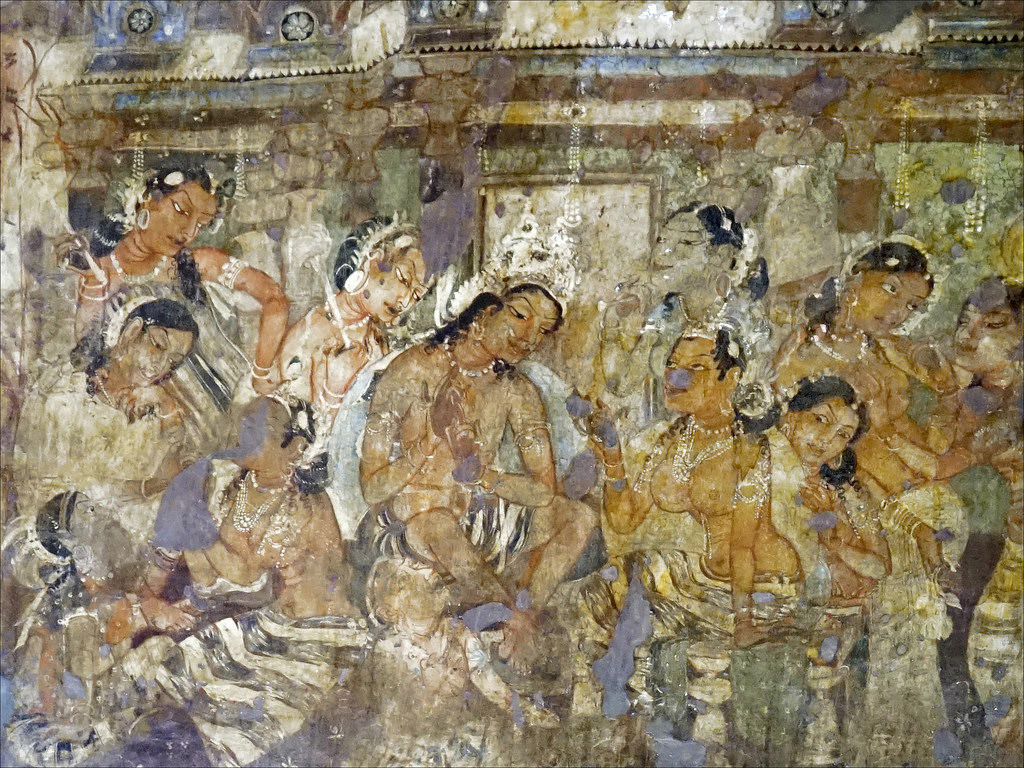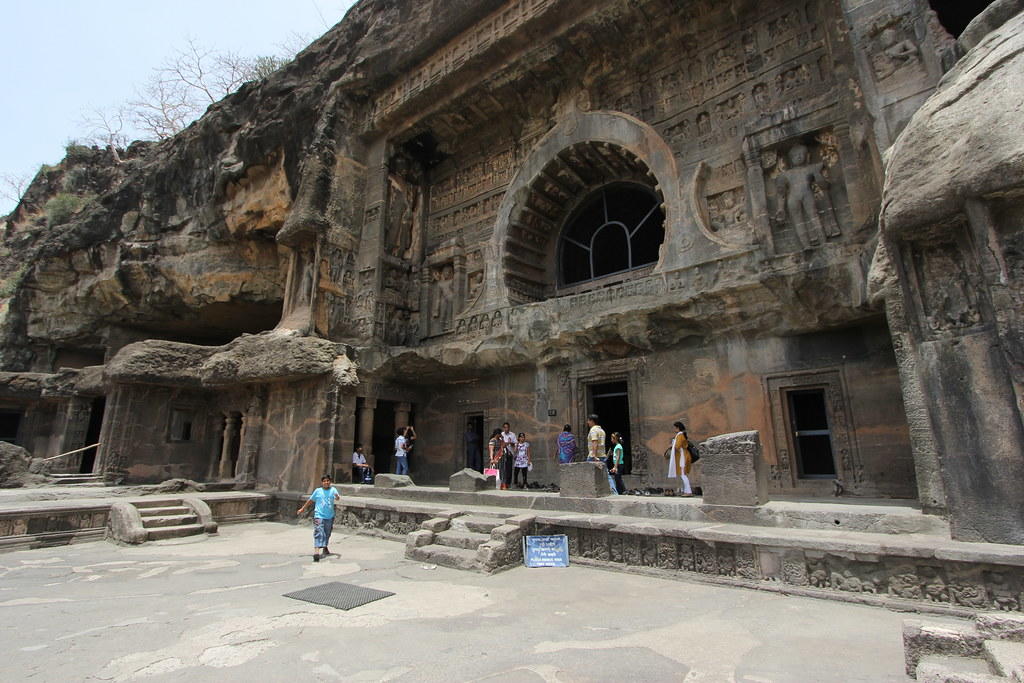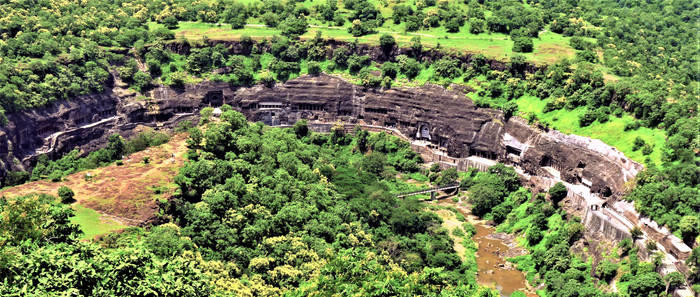To experience the art of the delayed revelation is to travel to Ajanta. Upon approaching from Aurangabad, the route initially falls into a valley from a plateau. At the World Heritage Site entry, you get off your bus or taxi and walk to the shuttle bus service. The bus trundles along the deep, forested gorge of River Waghora, carrying you and other visitors and Buddhist monks of various nationalities all the way to the gate's entrance. After that, you'll go along a lengthy ramp and up a number of steep steps to arrive at the caves.
Although a British hunting expedition "discovered" Ajanta in 1819, it is evident from their reports that the caves were already well-known to the nearby people. To all those involved, however, it remained a mystery. We now know a great deal more about Ajanta after a century and a half of scholarship, but this has also rendered the city even more mysterious.
Discover the romantic history of the Taj Mahal.

History of the Ajanta Caves
The Ajanta Caves had Buddhist prayer halls and monasteries cut out of a 250-foot wall. With sculptures of other Buddhist deities from the second to the fifth centuries BC, the paintings depicted the Buddha's many incarnations and lifetimes. In fact, the largest surviving examples of ancient Indian wall paintings may be seen in some of these caves. The caves were not public knowledge until the 17th century when a British commander on a hunting expedition happened to stumble upon them. Nonetheless, memoirs written by Chinese Buddhist travellers to India throughout the Middle Ages mention the Ajanta Caves.

Cave 10's entrance was the first cave that British officer John Smith found. He cleared a path to improve access to the caves with the help of the villagers living nearby. On one of the cave walls featuring a picture of a Bodhisattva, he even inscribed his name and the date. These caves were originally numbered from 1 to 29 once they were discovered.
Travel back in time to the majestic Konark Sun Temple in Odisha.
However, subsequently, other caves were discovered between the already-numbered ones, so those were marked with an alphabetic suffix, for example, 14A if the cave was discovered between 14 and 15. It should be noted, though, that this is the order in which the caverns were discovered, not the order in which they were constructed. After being discovered a few decades ago, the Ajanta Caves sprang to prominence as an exotic site featuring exquisite murals and a distinctive atmosphere.
Based on historical documents, the oldest group of caverns built were caverns 9, 10, 12, 13, and 15A. These were from the first or Satavahana Period and belonged to the Hinayana (smaller vehicle) style of Buddhism. The second phase began much later, in the 5th century, under the Vakataka Dynasty's Hindu Emperor Harishena. This stage of Buddhism is known as the Mahayana (larger vehicle) tradition. It is thought that at this time, the majority of the caverns were constructed, and several older ones were also renovated. This is the period of caves 1 through 8, 11, and 14 through 29.
Peek into the history of the Gateway of India and its importance for the British Empire.
However, throughout the colonial era, the caves fell within the domain of the Nizam of Hyderabad, not the British. Additionally, he built a road that led to the caves and restored the artwork in the 1920s, turning the location into a museum. For a small price, he invited travellers to visit the Ajanta Caves. The Maharashtra government constructed amenities and oversaw the historical site after independence. However, the early arrival of tourists also contributed to the caves' degradation.
The Ajanta caverns housed Buddhist monks and served as a site of religious practice, but even in that era, the paintings and murals inside the caverns were audacious and beautifully created. They were sensual, vibrant, and full of life, appreciating the physical beauty of both men and women. The artwork of Ajanta Caves includes elaborate scenes, decorative themes, and paintings depicting events from the life of the Buddha. When the paintings in these caves started to fade, numerous attempts were made in the past to replicate them in other regions of the world. Nevertheless, natural disasters destroyed most of it.
Trace India's spiritual roots with a history of the Khajuraho temples.
The majority of the Ajanta caves were either chaityagriha or prayer halls also known as the "house of the stupas," or viharas, or monasteries. The architectural style adopted for building these caverns was Cathedral architecture and hence they resembled a Christian church without the chapel or cross.
A common feature of many caves was the high ceiling, as well as the carved doorways, windows, and walkways behind the stupas for Pradakshina. The Ajanta caverns' murals not only impacted Indian art but also that of Tibet and Sri Lanka, despite the fact that the caverns are primarily Buddhist in nature. The caves were constructed by Hindus since, at the time, Buddhism was highly regarded in Indian society. The names of several Hindu donors who helped build the caverns and other Buddhist holy facilities are written on the walls inside the caves.
Learn the fascinating history of Charminar, Hyderabad's crowning jewel.
When visiting, make sure to view Caves 1, 2, 4, 9, 10, and 17. One of the most ornate façades, featuring sculptures, ornamental carvings, and embellishments, is Cave 1. It's also the first cave you'll come upon in this area. Buddha life stories are portrayed in paintings that adorn the walls of Cave 1. Cave 2, which is better preserved and has paintings of strong women, deities, and goddesses, is next to Cave 1. The largest monastery ever planned but never completed is thought to be Cave 4. It has a hall, a verandah, and a sanctum with incomplete cells. It also features a picture of Buddha preaching, flanked on both sides by bodhisattvas and celestial nymphs.

The halls of worship known as chaityagrihas, or caves 9, and 10, were constructed at least a century apart. There is no common theme among the dispersed paintings in Cave 10, which feature the creations of several artists. Many projects are still unfinished. There are some of the best-preserved paintings in Cave 17, a monastery or vihara.
Two enormous stone elephants guard the entry, and inside are several pillars, each with its own unique style, as well as a porch. The walls of this cave are adorned with carvings of Buddha, Indian gods and goddesses, artists, and kings. The walls also display other scenes of women applying makeup, lovers, couples, wine-drinking events, etc.
As the world's foremost authority on the Ajanta caverns, Professor Walter M. Spink is well respected for his studies and the chronological techniques he employed to establish the dates of the caverns' excavations. After admiring the Ajanta Caves' magnificence, proceed to Ellora Caves, which showcase a variety of life experiences besides Buddhism.
Travel to India's seat of political power and unravel the History of the Red Fort.
Ajanta Caves Paintings
Since other types of painting from roughly 1000 C.E., such as palace murals and paintings on wood, cloth, or palm leaf, have not survived, the Ajanta Cave paintings are the oldest and most significant wall paintings in India. The method and approach employed to produce the Ajanta cave paintings are exclusive to South Asian art history and are unlike any other artwork discovered in the art histories of other civilizations.
The intricate Jataka story compositions and elaborate flower and animal designs adorned the caverns' walls, ceilings, and columns. The world portrayed in the paintings is one in which noblemen coexist peacefully with a bountiful natural environment. The painting's vibrancy and richness imply that the painters were used to creating both secular and religious pieces.
There were multiple steps in the painting process. In order to support a plaster composed of clay, hay, dung, and lime over a clay underlayer, the rock surface had first been chipped to a sufficiently rough texture. Cave to cave varies in what materials are used and in what amounts.
The sketches were outlined and coloured while the plaster was still wet. The colour was able to seep into the moist plaster, becoming a part of the surface and resistant to easy peeling off or deterioration. The hues were called "vegetable colours" or "earth colours." To create varied hues, a variety of plants, minerals, and stones were combined. Twigs and animal hair were used to make the paintbrushes used to create the artwork.
Discover the towering glory that is the Qutab Minar through a historical lens.
Ajanta Caves: Information for Tourists
All days of the week save Mondays are open for visitors to the Ajanta Caves year-round. The caves are open to visitors from 9.30 am until 5.30 pm. The ASI website now offers online ticket booking, so you can do it in advance of your visit. If you intend to make a group reservation, be aware that their website does not allow you to reserve more than 20 adult and 10 child tickets at once.

Entrance is free for children under 15 and costs Rs 30 for individuals over 15. The cost of the ticket is the same for Indians and residents of SAARC countries such as Nepal, Bhutan, Maldives, Pakistan, Sri Lanka, and Myanmar. However, the cost of a ticket for foreign nationals of other nations is Rs 250 for each visit. You can purchase a still and video camera for Rs 5 to bring them into the caves. But keep in mind that flash cannot be used for photography.
Marvel at India's architectural glory through a history of the Ellora Caves.
It is advisable to plan your return travel in advance of your visit, as it might be challenging to find transportation out of the caves. To save yourself trouble later, rent a taxi for the entire journey or bring your own car. The Ajanta Caves were chosen by the UNESCO World Heritage Centre in 1983 to be included in their preservation efforts. The Ajanta caves are still among India's most popular tourist destinations for architecture. They are a living example of one of the most opulent artistic movements in Indian history and art.















